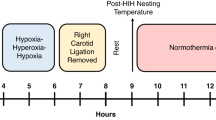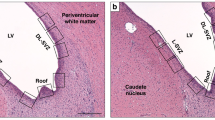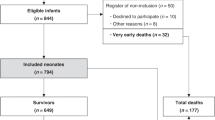Abstract
The neuroprotective efficacy of hypothermia (HT) after hypoxia-ischemia (HI) falls dramatically the longer the delay in initiating HT. Knowledge is scarce regarding protective or adverse effects of HT in organs beyond the brain. In addition, the relative effectiveness of selective head cooling (SHC) and whole body cooling (WBC) has not been studied. We aimed to examine whether 24 h HT, initiated 3 h after global HI is brain- and/or organ-protective using pathology, neurology, and biochemical markers. Fifty, ≤1-d-old pigs were subjected to global HI causing permanent brain injury. Animals were randomized to normothermia (NT), (Trectal) 39.0°C, SHCTrectal 34.5°C, or WBCTrectal 34.5°C for 24 h, all followed by 48 h NT. There was no difference in injury to the brain or organs between groups. There was no gender difference in brain injury but females had significantly more organs injured [2.3 (± 1.3) [mean ± SD] vs. 1.4 ± (1.0)]. The postinsult decline in lactate was temperature independent. However, HT animals normalized their plasma-calcium, magnesium, and potassium significantly faster than NT. Delayed SHC or WBC, initiated 3 h after HI, does not reduce pathology in the brain nor in organs. Delayed HT improves postinsult recovery of plasma-calcium, magnesium, and potassium. There were no differences in adverse effects across groups.
Similar content being viewed by others
Log in or create a free account to read this content
Gain free access to this article, as well as selected content from this journal and more on nature.com
or
Abbreviations
- AUC:
-
area under curve
- HI:
-
hypoxia-ischemia
- HIE:
-
hypoxic ischemic encephalopathy
- HT:
-
hypothermia
- IQR:
-
interquartile range
- MABP:
-
mean arterial blood pressure
- MOD:
-
multiorgan dysfunction
- NT:
-
normothermia
- SHC:
-
selective head cooling
- Trectal:
-
rectal temperature
- UVC:
-
umbilical vein catheter
- WBC:
-
whole body cooling
References
Thoresen M, Penrice J, Lorek A, Cady EB, Wylezinska M, Kirkbride V, Cooper CE, Brown GC, Edwards AD, Wyatt JS, Reynolds EO 1995 Mild hypothermia after severe transient hypoxia-ischemia ameliorates delayed cerebral energy failure in the newborn piglet. Pediatr Res 37: 667–670
Tooley JR, Satas S, Porter H, Silver IA, Thoresen M 2003 Head cooling with mild systemic hypothermia in anesthetized piglets is neuroprotective. Ann Neurol 53: 65–72
Gunn AJ, Gunn TR, de Haan HH, Williams CE, Gluckman PD 1997 Dramatic neuronal rescue with prolonged selective head cooling after ischemia in fetal lambs. J Clin Invest 99: 248–256
Bona E, Hagberg H, Loberg EM, Bagenholm R, Thoresen M 1998 Protective effects of moderate hypothermia after neonatal hypoxia-ischemia: short- and long-term outcome. Pediatr Res 43: 738–745
Hobbs C, Thoresen M, Tucker A, Aquilina K, Chakkarapani E, Dingley J 2008 Xenon and hypothermia combine additively, offering long-term functional and histopathological neuroprotection after neonatal hypoxia/ischemia. Stroke 39: 1307–1313
Gunn AJ 2000 Cerebral hypothermia for prevention of brain injury following perinatal asphyxia. Curr Opin Pediatr 12: 111–115
Taylor DL, Mehmet H, Cady EB, Edwards AD 2002 Improved neuroprotection with hypothermia delayed by 6 hours following cerebral hypoxia-ischemia in the 14-day-old rat. Pediatr Res 51: 13–19
Gluckman PD, Wyatt JS, Azzopardi D, Ballard R, Edwards AD, Ferriero DM, Polin RA, Robertson CM, Thoresen M, Whitelaw A, Gunn AJ 2005 Selective head cooling with mild systemic hypothermia after neonatal encephalopathy: multicentre randomised trial. Lancet 365: 663–670
Shankaran S, Laptook AR, Ehrenkranz RA, Tyson JE, McDonald SA, Donovan EF, Fanaroff AA, Poole WK, Wright LL, Higgins RD, Finer NN, Carlo WA, Duara S, Oh W, Cotten CM, Stevenson DK, Stoll BJ, Lemons JA, Guillet R, Jobe AH 2005 Whole-body hypothermia for neonates with hypoxic-ischemic encephalopathy. N Engl J Med 353: 1574–1584
Eicher DJ, Wagner CL, Katikaneni LP, Hulsey TC, Bass WT, Kaufman DA, Horgan MJ, Languani S, Bhatia JJ, Givelichian LM, Sankaran K, Yager JY 2005 Moderate hypothermia in neonatal encephalopathy: safety outcomes. Pediatr Neurol 32: 18–24
Schulzke SM, Rao S, Patole SK 2007 A systematic review of cooling for neuroprotection in neonates with hypoxic ischemic encephalopathy—are we there yet?. BMC Pediatr 7: 30
Lorek A, Takei Y, Cady EB, Wyatt JS, Penrice J, Edwards AD, Peebles D, Wylezinska M, Owen-Reece H, Kirkbride V, Cooper RF, Alldridge RF, Roth SC, Brown G, Delpy DT, Reynolds EO 1994 Delayed (“secondary”) cerebral energy failure after acute hypoxia-ischemia in the newborn piglet: continuous 48-hour studies by phosphorus magnetic resonance spectroscopy. Pediatr Res 36: 699–706
Thoresen M, Haaland K, Loberg EM, Whitelaw A, Apricena F, Hanko E, Steen PA 1996 A piglet survival model of posthypoxic encephalopathy. Pediatr Res 40: 738–748
Haaland K, Loberg EM, Steen PA, Thoresen M 1997 Posthypoxic hypothermia in newborn piglets. Pediatr Res 41: 505–512
Satas S, Loberg EM, Porter H, Whitelaw A, Steen PA, Thoresen M 2003 Effect of global hypoxia-ischaemia followed by 24 h of mild hypothermia on organ pathology and biochemistry in a newborn pig survival model. Biol Neonate 83: 146–156
Gressens P, Dingley J, Plaisant F, Porter H, Schwendimann L, Verney C, Tooley J, Thoresen M 2008 Analysis of neuronal, glial, endothelial, axonal and apoptotic markers following moderate therapeutic hypothermia and anesthesia in the developing piglet brain. Brain Pathol 18: 10–20
Thoresen M, Haaland K, Steen PA, Thoresen M, Haaland K, Steen PA 1994 Cerebral doppler and misrepresentation of flow changes. Arch Dis Child 71: F103–F106
Schubert A, Schubert A 1995 Side effects of mild hypothermia. J Neurosurg Anesthesiol 7: 139–147
Amess PN, Penrice J, Howard S, Thoresen M, Edwards AD, Cady EB, Wyatt JS, Sams V 1998 Organ pathology following mild hypothermia used as neural rescue therapy in newborn piglets. Biol Neonate 73: 40–46
Bernhard WF, Mc MJ, Curtis GW 1955 Feasibility of partial hepatic resection under hypothermia. N Engl J Med 253: 159–164
Qing M, Nimmesgern A, Heinrich PC, Schumacher K, Vazquez-Jimenez JF, Hess J, von Bernuth G, Seghaye MC 2003 Intrahepatic synthesis of tumor necrosis factor-alpha related to cardiac surgery is inhibited by interleukin-10 via the Janus kinase (Jak)/signal transducers and activator of transcription (STAT) pathway. Crit Care Med 31: 2769–2775
deSa DJ 1995 Pulmonary complications of assisted ventilation. deSa DJ Pathology of Neonatal Intensive Care. Chapman & Hall, London 28–47
Cohen IT, Nelson SD, Moxley RA, Hirsh MP, Counihan TC, Martin RF 1991 Necrotizing enterocolitis in a neonatal piglet model. J Pediatr Surg 26: 598–601
Haaland K, Loberg EM, Steen PA, Satas S, Thoresen M 1997 The effect of mild post-hypoxic hypothermia on organ pathology in a piglet survival model of global hypoxia. Prenat Neonatal Med 2: 329–337
Frink M, Pape HC, van Griensven M, Krettek C, Chaudry IH, Hildebrand F 2007 Influence of sex and age on mods and cytokines after multiple injuries. Shock 27: 151–156
Jensen A, Garnier Y, Berger R 1999 Dynamics of fetal circulatory responses to hypoxia and asphyxia. Eur J Obstet Gynecol Reprod Biol 84: 155–172
Johnston MV, Hagberg H 2007 Sex and the pathogenesis of cerebral palsy. Dev Med Child Neurol 49: 74–78
Yoneda S, Ibara S, Kobayashi K, Kato E, Maruyama Y, Maruyama H, Sumida Y, Sunami R, Sakai M, Ikenoue T, Saito S 2005 Low adjusted serum ionized calcium concentration shortly after birth predicts poor outcome in neonatal hypoxic-ischemic encephalopathy. J Obstet Gynaecol Res 31: 57–64
Bickler PE, Hansen BM 1994 Causes of calcium accumulation in rat cortical brain slices during hypoxia and ischemia: role of ion channels and membrane damage. Brain Res 665: 269–276
Johnston MV 1993 Cellular alterations associated with perinatal asphyxia. Clin Invest Med 16: 122–132
Ilves P, Blennow M, Kutt E, Magi ML, Kudrjavtseva G, Lagercrantz H, Talvik T 1996 Concentrations of magnesium and ionized calcium in umbilical cord blood in distressed term newborn infants with hypoxic-ischemic encephalopathy. Acta Paediatr 85: 1348–1350
Acknowledgements
The authors thank the following companies for lending us equipment used in this study; Olympic Medical (CoolCare cooling system), SLE (neonatal ventilator), Radiometer (blood gas machine and co-oximeter) and Datex-Ohmeda (Giraffe incubator).
Author information
Authors and Affiliations
Corresponding author
Additional information
This work was supported by The Wellcome Trust (UK), who provided the main funding, along with support from Laerdal Foundation for Acute Medicine (Norway), The Swedish Medical Research Council and Research and Public Health in Värmland.M.K. and J.R.T. contributed equally to this study.
Rights and permissions
About this article
Cite this article
Karlsson, M., Tooley, J., Satas, S. et al. Delayed Hypothermia as Selective Head Cooling or Whole Body Cooling Does Not Protect Brain or Body in Newborn Pig Subjected to Hypoxia-Ischemia. Pediatr Res 64, 74–80 (2008). https://doi.org/10.1203/PDR.0b013e318174efdd
Received:
Accepted:
Issue date:
DOI: https://doi.org/10.1203/PDR.0b013e318174efdd
This article is cited by
-
Rewarming from Therapeutic Hypothermia Induces Cortical Neuron Apoptosis in a Swine Model of Neonatal Hypoxic–Ischemic Encephalopathy
Journal of Cerebral Blood Flow & Metabolism (2015)
-
Minimal systemic hypothermia combined with selective head cooling evaluated in a pig model of hypoxia-ischemia
Pediatric Research (2015)
-
Adding 5 h delayed xenon to delayed hypothermia treatment improves long-term function in neonatal rats surviving to adulthood
Pediatric Research (2015)
-
Cardiac troponin I concentrations as a marker of neurodevelopmental outcome at 18 months in newborns with perinatal asphyxia
Journal of Perinatology (2014)
-
Physiologic and pharmacologic considerations for hypothermia therapy in neonates
Journal of Perinatology (2011)



